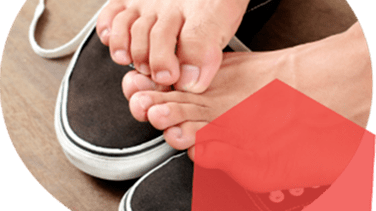There are two types of fungus and their causes are very similar as they are caused by the same virus. Let's learn more about the treatment and prevention of each and every one of them.
Athlete's foot
Athlete's foot is the most common fungal infection, affecting around 15% of the world's population.

Men are usually more prone to this infection and the likelihood of developing athlete's foot increases as they age.
The good news is that you can get rid of athlete's foot with proper and timely treatment. It must be started immediately after the first symptoms of the fungus appear.
If your athlete's foot causes severe discomfort and pain, you should see your doctor.
How does athlete's foot develop?
Athlete's foot or mycosis get their name from the environment in which the fungal bacteria feel most comfortable (namely in a warm, humid environment, for example in athletes' sneakers).
Any shoe that sweats a lot and the skin cannot breathe can potentially contribute to the development of fungus.
What are the symptoms of the spread of the infection
The most common symptoms of athlete's foot are itching, swelling, redness, and flaking. The most common athlete's foot occurs between the toes. Fortunately, the fungus only affects the outer layers of the skin.
How the infection spreads
Athlete's foot spreads quite easily and quickly. Infection in affected cells can remain viable for up to two years.
The easiest way to get an infection is in a humid and warm environment.
Pools, changing rooms, and showers are examples of such locations. This is why it is so important to wear interchangeable shoes and not go barefoot in such public places.
People with diabetes can also be easy targets for athlete's foot.
How to prevent athlete's foot
Regularly wash your feet in soap and warm water, dry them thoroughly, and remove moisture from your skin, especially in the area between your toes. Also, try not to use other people's towels.
Special foot powder absorbs excess moisture from leather and shoes. Try to keep your feet, socks, and shoes clean.
Wear open-toed shoes made of breathable materials as often as possible, as the pores of the skin on an adult's legs produce an amount of sweat per day in the summer, the volume of which is comparable to that of an egg.
When choosing socks and shoes, opt for natural fabrics. Change your socks and shoes every day to allow them to dry completely inside.
If you've found out that a particular pair you keep coming across mushrooms, wouldn't it be easier to throw them away? Even if these are your favorite shoes, they are too much of a chore for you.
Which treatment should I choose?
In pharmacies you can find a wide range of different means of combating fungi, and especially athlete's foot. It is important to complete the entire course of treatment, even if you no longer bother with the symptoms of the fungus. This will help eliminate the fungal infection completely.
Nail fungus
Nail fungus(Onychomycosis) affects the keratin component of the nails. In some cases the entire nail including the nail plate, bed and nail root can be damaged, in other cases it can be limited to only part of the nail.
In total, 2% to 18% of the total population of the world suffer from this type of fungus.
A fungal nail infection spreads slowly, so you may not even notice symptoms at first. As a rule, this disease is not painful and you can easily manage it at home.
It is important to know
Fungal nail bacteria, also called dermatophytes, cause fungi. Sometimes another type of yeast infection known as candida can also be the cause.
Athlete's foot can easily develop into nail fungus. Therefore, it is important to act quickly to stop the infection from spreading in the early stages.
Symptoms of nail fungus
Early signs of nail fungus are discoloration, thinning, and splitting of the nails.
Over time, the nail can become brittle and even separate from the toe. The skin around the nail can become inflamed, causing pain and discomfort.
How to prevent fungus from developing
Avoid wearing shoes that sweat profusely on your feet, trim your toenails regularly, and follow simple hygiene practices.
How to treat nail fungus
Means of combating fungal infections help create unbearable conditions for destroying the cause of the disease and preventing the spread of infection.
First and foremost, make it a rule to trim your toenails every week and do a fungus treatment every day for a month.
After that, you need to treat your nails with a special tool every week to get rid of the infection for another 9 months so that after a few days the fungus does not reappear.
In 9 months, you can get your nails back to a healthy state and completely eliminate the symptoms of the fungus. It is very important to complete the entire course of treatment. For more detailed instructions for use, see the product note.



























